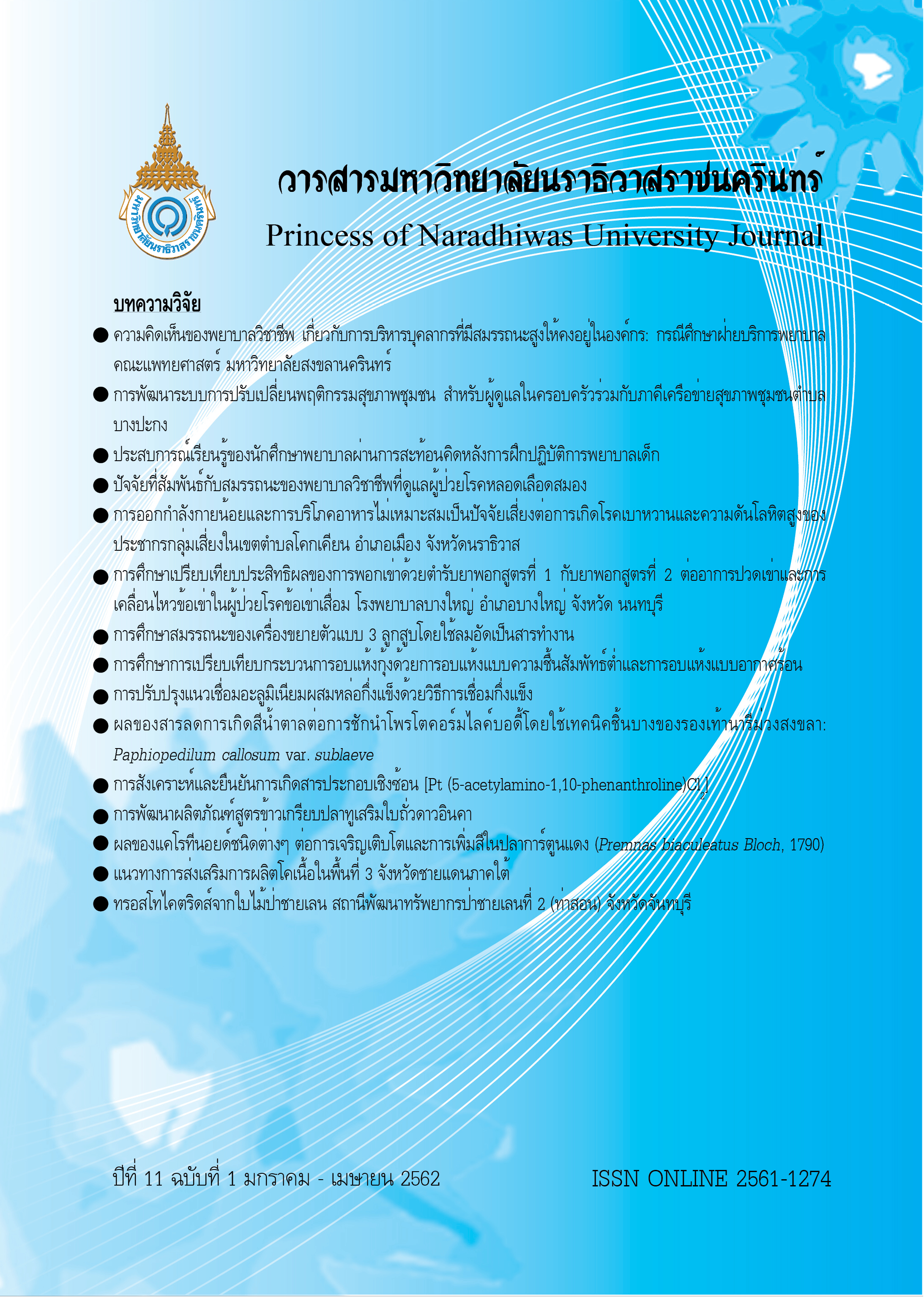Less Physical Activity and Inappropriate Food Consumption were Risk Factors for Diabetes Mellitus and Hypertension among Risk Group in Khokkhian Subdistrict, Mueang District, Narathiwat Province
Keywords:
Diabetes mellitus, Hypertension, Risk groupAbstract
The objectives of this study were to investigate knowledge, risk factor awareness, and risk behaviors
with the factors associated risk behaviors of the risk groups in diabetes mellitus (DM) and hypertension. A total of 244 participants at risk aged 45 years and over were recruited from Khokkhian subdistrict, Mueang district, Narathiwat Province. Questionnaires were used as the instrument for data collection with the assessment of content validity (IOC =0.76). Descriptive statistics and Chi-square tests were performed for data analysis.
The result showed that participants had 53.9% of body mass index (BMI) higher than standard level.
Regarding to diabetes and hypertension, the high level of knowledge was 77.5% and 75.4%, whereas the
moderate level of awareness of risk factor was 53.3% and 42.2%, respectively. However, overall risk behaviors of diabetes and hypertension were moderate level ( =0.77). Moreover, positive/protective factors-taking behaviors were poor practice; stress, alcohol drinking and smoking, including taking drug and hormone. On the other hand, negative/risk factors-taking behaviors were food consumption and physical activity. The physical activity was significant correlated with education (p=.005) and income (p<.001). Participants with primary school and average income (less than 6,000 baht per month) presented risk of diabetes and hypertension due to less physical activity and more consumption of fried food and dessert. That was consistent with a higher percentage of BMI than the range of standard
References
Alejandro, E. U., Gregg, B., Blandino-Rosano, M., Cras-Meneur, C., & Bernal-Mizrachi, E. (2015). Natural history of beta-cell adaptation and failure in type 2 diabetes. Molecular Aspects of Medicine, 42, 19-41.
Brender, J. R., Hartman, K., Nanga, R. P., Popovych, N., de la Salud Bea, R., Vivekanandan, S., et.al. (2010). Role of zinc in human islet amyloid polypeptide aggregation. Journal of the American Chemical Society, 132(26), 8973-8983.
Buford, T. W. (2016). Hypertension and aging. Ageing Research Reviews, 26, 96-111. Bureau of non-communicable diseases, Department of disease control. (2015). Hypertension in non-communicable disease risk and injury survey in 2015. Retrieved 20 July 2018 from http://www.thaincd.com/2016/ mission6 (in Thai)
Bureau of non-communicable diseases, Department of disease control. (2016). Thai health survey by physical
examination, 5th, 2014. Retrieved 23 July 2018 from http://www.thaincd.com/2016/mission/ documents.php?tid=32&gid=1-021 (in Thai)
Bureau of non-communicable diseases, Department of disease control. (2017). A guide to the prevention and
control of diabetes and hypertension (for support of NCD clinic plus operations). Retrieved 9 May 2018 from http://www.thaincd.com/2016/media-detail.php?id=12635&tid=1-001-001&gid=1-015-005 (in Thai)
de Souza, R. J., Mente, A., Maroleanu, A., Cozma, A. I., Ha, V., Kishibe, T., et.al. (2015). Intake of saturated and trans unsaturated fatty acids and risk of all cause mortality, cardiovascular disease, and type 2 diabetes: systematic review and meta-analysis of observational studies. BMJ, 351, h3978.
Di Genova, L., Cerquiglini, L., Penta, L., Biscarini, A., & Esposito, S. (2018). Pediatric Age Palm Oil Consumption.
International Journal of Environmental Research and Public Health, 15(4). Retrieved 9 May 2018 from https://www.mdpi.com/1660-4601/15/4/651/pdf
Farha, W., Abd El-Aty, A. M., Rahman, M. M., Jeong, J. H., Shin, H. C., Wang, J., et.al.(2018). Analytical approach, dissipation pattern and risk assessment of pesticide residue in green leafy vegetables: A comprehensive review. Biomedical Chromatography, 32(1). doi: 10.1002/bmc.4134.
International Diabetes Federation: IDF. (2017). IDF Diabetes Atlas 8th Edition. Retrieved 23 July 2018 from https://www.idf.org/e-library/epidemiology-research/diabetes-atlas.html
Ketsing, W. (1998). Analytical Statistics for Research. Bangkok: Thai Wattana Panich. (in Thai)
Khokkhian health promoting hospital. (2017). Annual Report 2016. (pp.23-25) (in Thai)
Mashmula, M., & Nima, Y. (2009). Integration of knowledge on Islamic law of chronic diseases. (Cardiovascular disease, diabetes, hypertension). Southern Health System Research Institute: Prince of Songkla University. (in Thai)
Mukherjee, S., & Mitra, A. (2009). Health Effects of Palm Oil. Journal of Human Ecology, 26(3), 197-203.
Narathiwat provincial health office. (2017). The Annual Health Sector Performance Report 2016. (pp.22-23) (in Thai)
Pereira, C., Li, D., & Sinclair, A. J. (2001). The alpha-linolenic acid content of green vegetables commonly available in Australia. International Journal for Vitamin and Nutrition Research, 71(4), 223-228.
Stanger, B. Z., Tanaka, A. J., & Melton, D. A. (2007). Organ size is limited by the number of embryonic progenitor cells in the pancreas but not the liver. Nature, 445(7130), 886-891.
Sullivan, D. H., & Johnson, L. E. (2017). Nutrition and Obesity. In J. B. Halter, J. G. Ouslander, S. Studenski, K. P. High, S. Asthana, M. A. Supiano, & C. Ritchie (Eds.), Hazzard’s Geriatric Medicine and Gerontology, 7e. New York, NY: McGraw-Hill Education.
World Health Organization: WHO. (2012). New data highlight increases in hypertension, diabetes incidence. Retrieved 23 July 2018 from http://www.who.int/mediacentre/news/releases/2012/ world_health_statistics_20120516/en/
World Health Organization: WHO. (2015). Hypertension in Thailand. Retrieved 23 July 2018
http://www.searo.who.int/thailand/news/hypertension-in-thailand/en/
World Health Organization: WHO. (2018). Diabetes mellitus. Retrieved 21 July 2018 http://www.who.int/ mediacentre/factsheets/fs138/en/
Williams, P. T. (2008). Vigorous exercise, fitness and incident hypertension, high cholesterol, and diabetes. Medicine & Science in Sports & Exercise, 40(6), 998-1006.
Williams, P. T., & Thompson, P. D. (2013). Walking versus running for hypertension, cholesterol, and diabetes mellitus risk reduction. Arteriosclerosis, Thrombosis, and Vascular Biology, 33(5), 1085-1091.
Yamane, T. (1967). Statistics: An Introductory Analysis. New York: Harper & Row.
Yang, Y., Liu, B., Gao, L., Li, Q., Wang, H., & Wang, L. (2018). Impact of 1,25(OH) 2 D 3 on TG content in liver of rats with type 2 diabetes. Acta Cirurgica Brasileira, 33(6), 542-550.
Yu, R., Yan, L. L., Wang, H., Ke, L., Yang, Z., Gong, E., et.al. (2014). Effectiveness of a community-based individualized lifestyle intervention among older adults with diabetes and hypertension, Tianjin, China, 2008-2009. Preventing Chronic Disease, 11, E84




